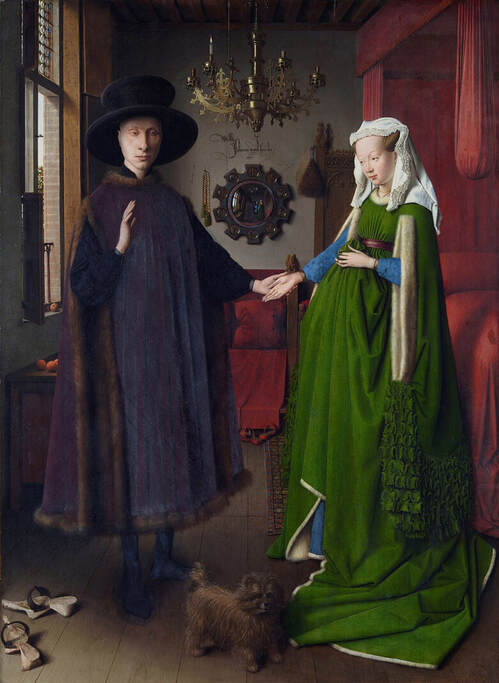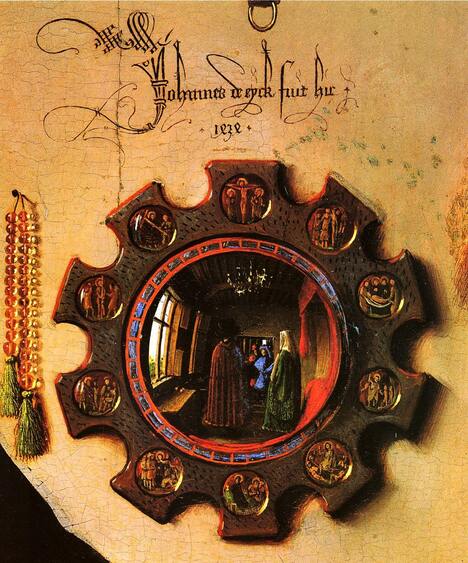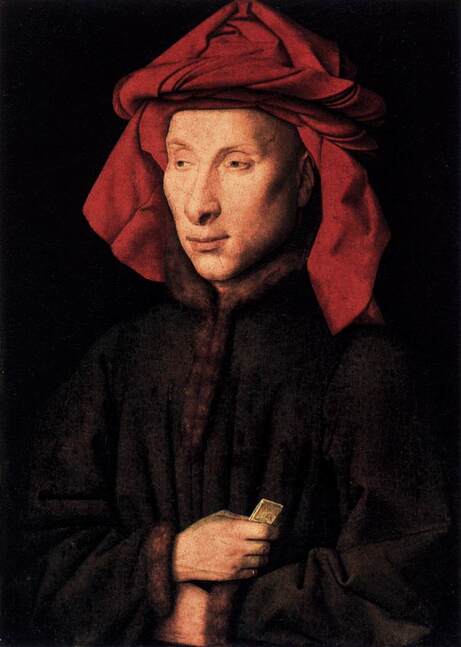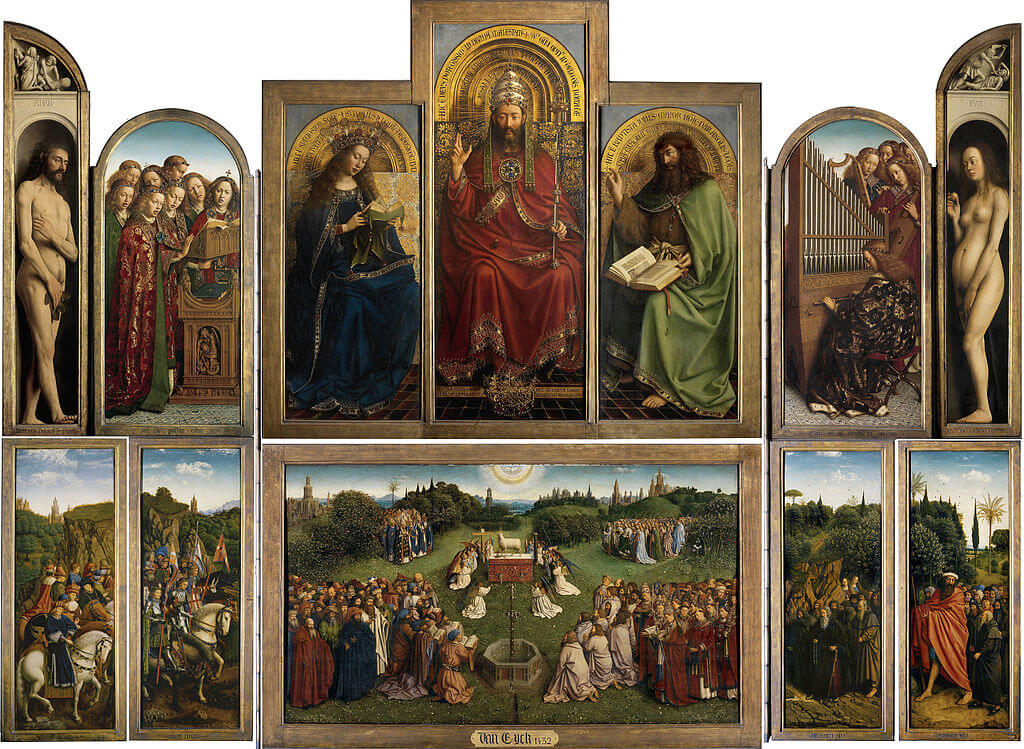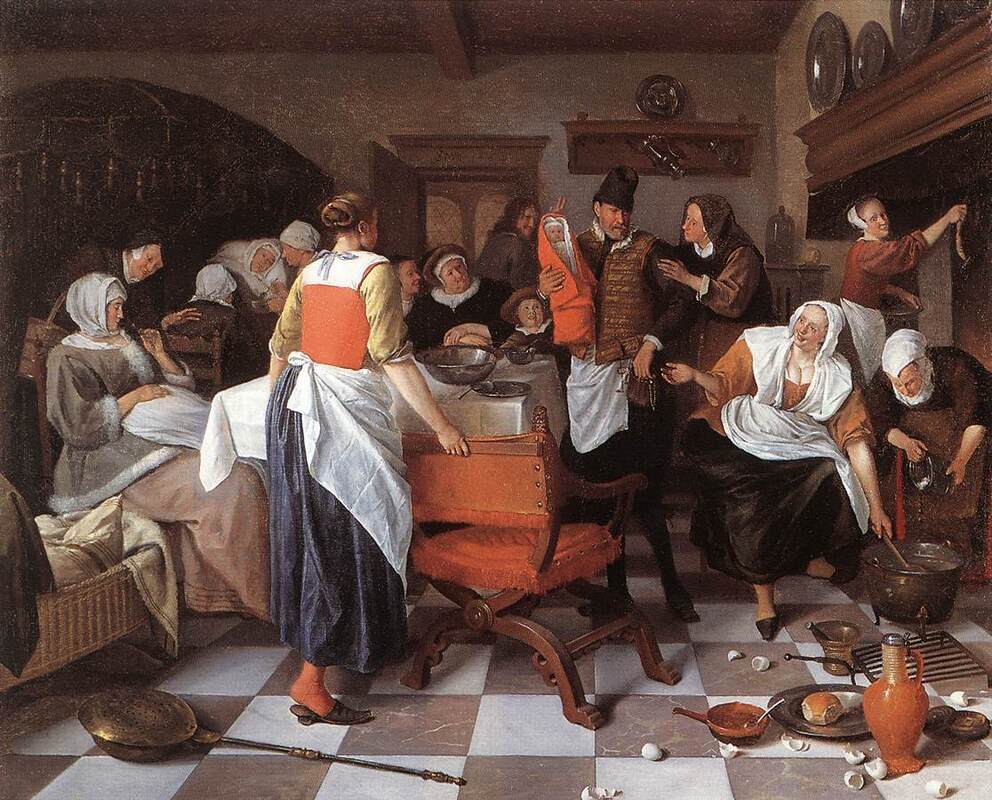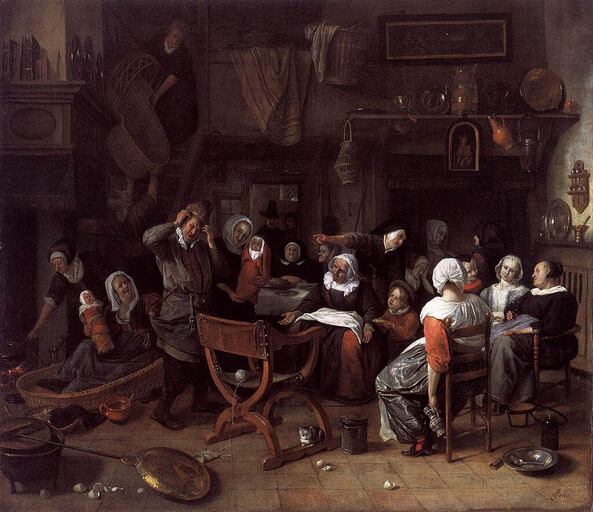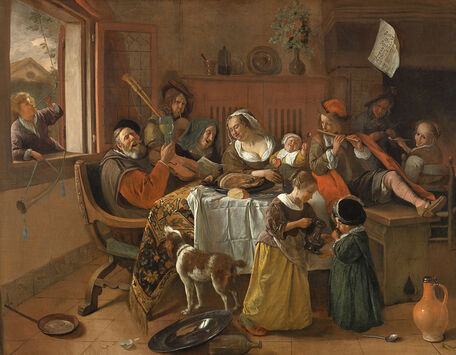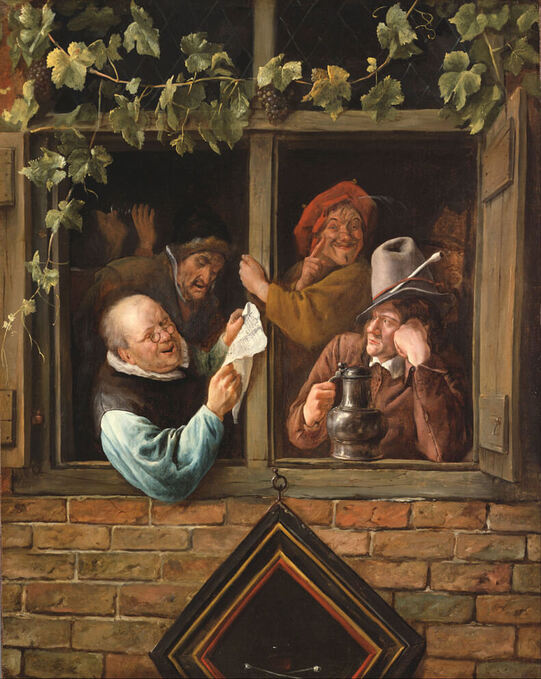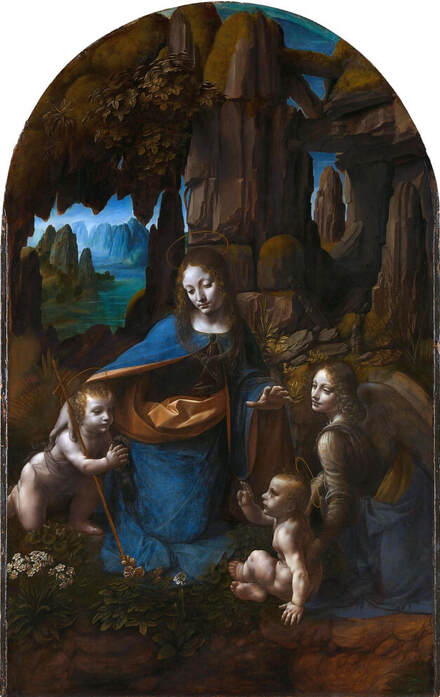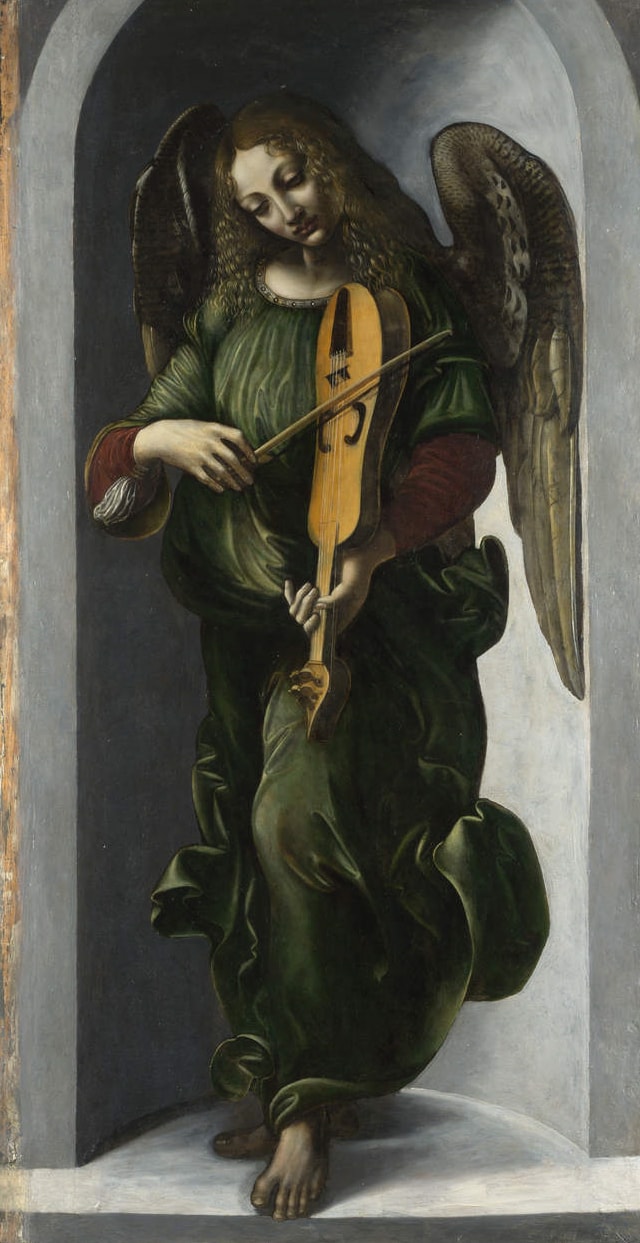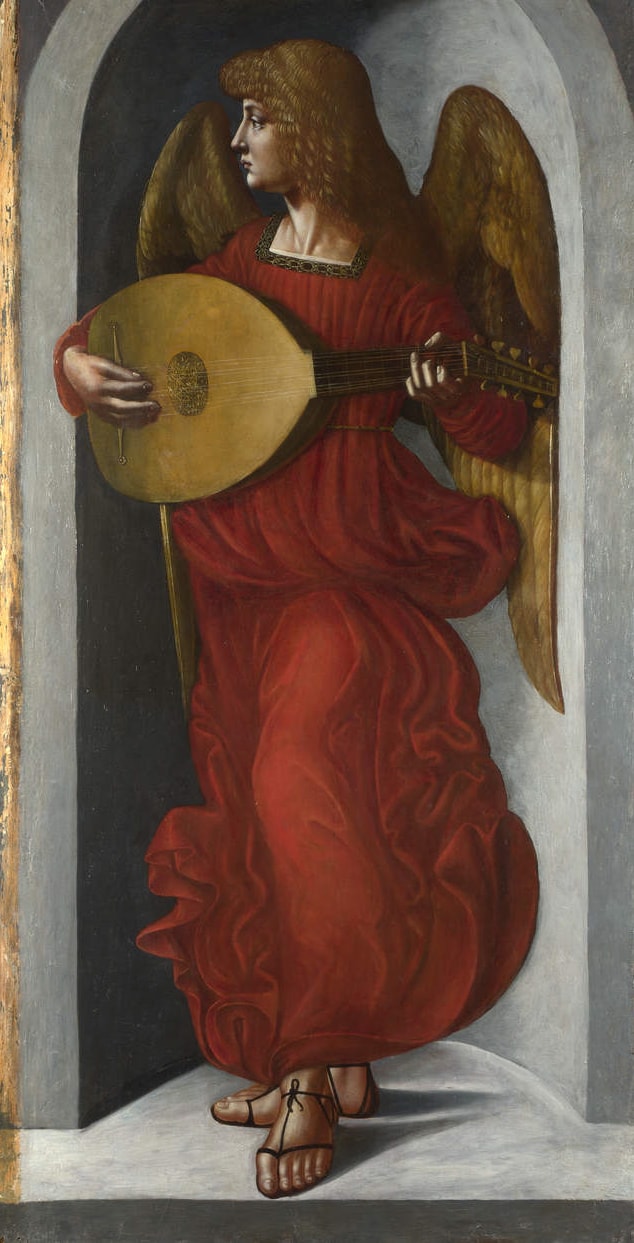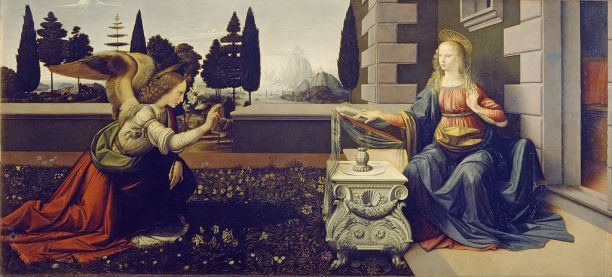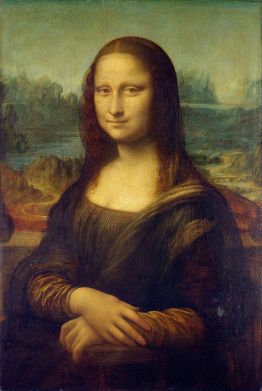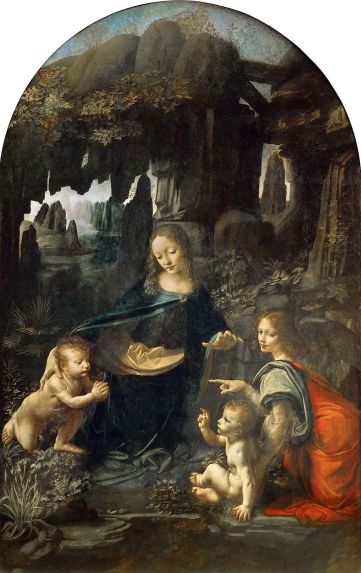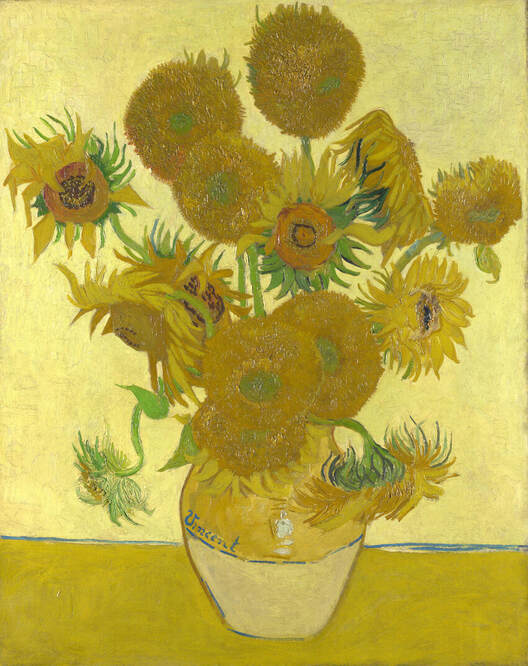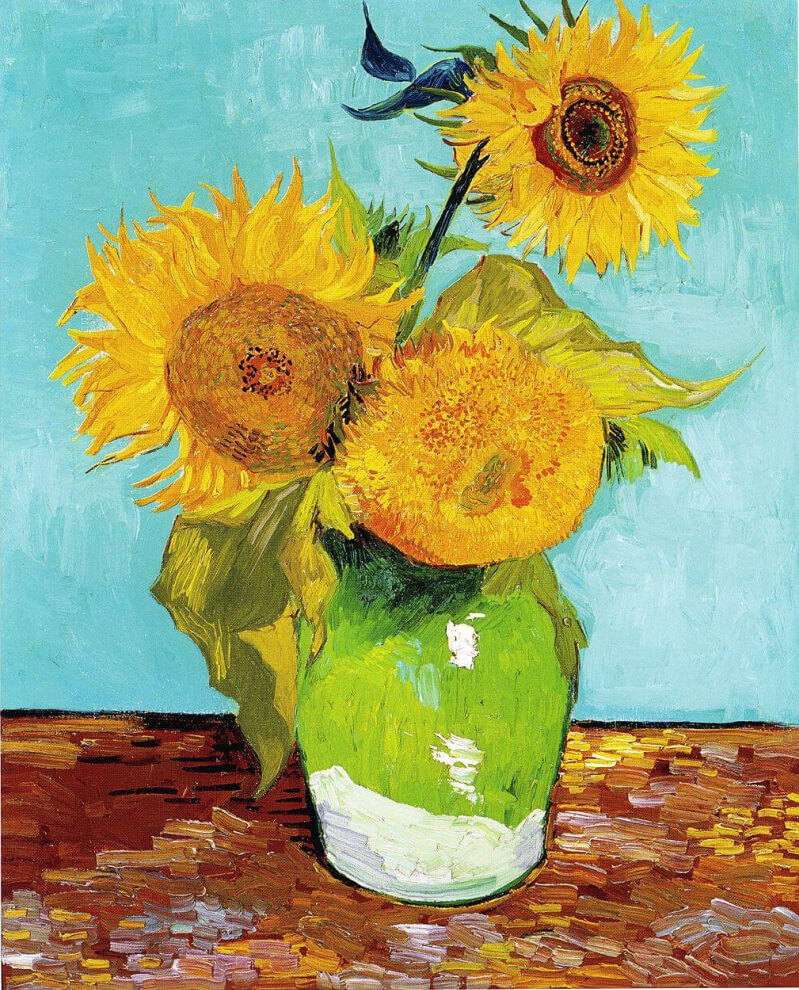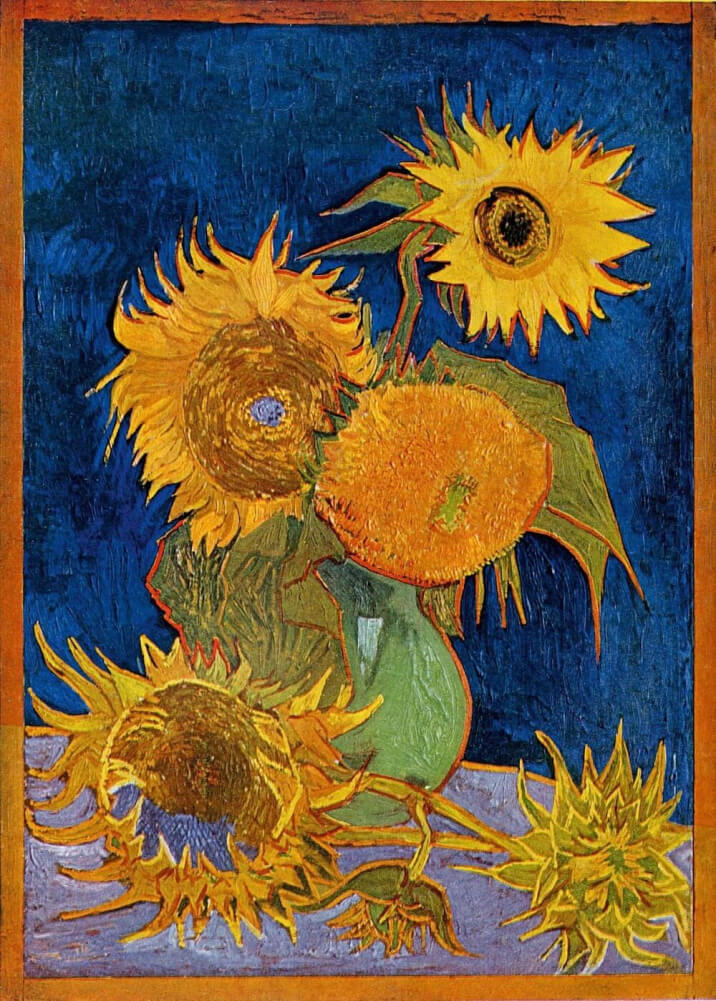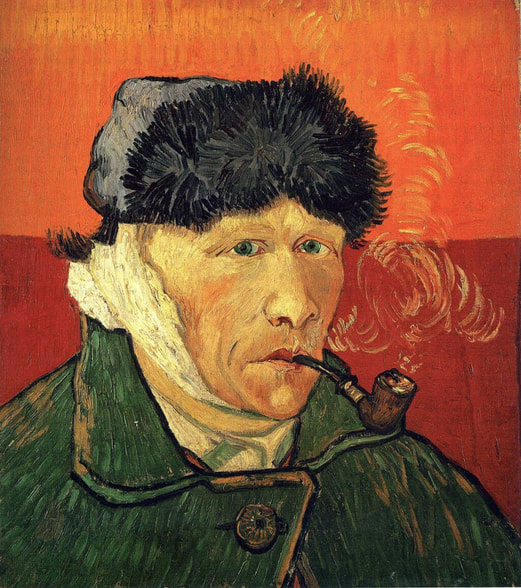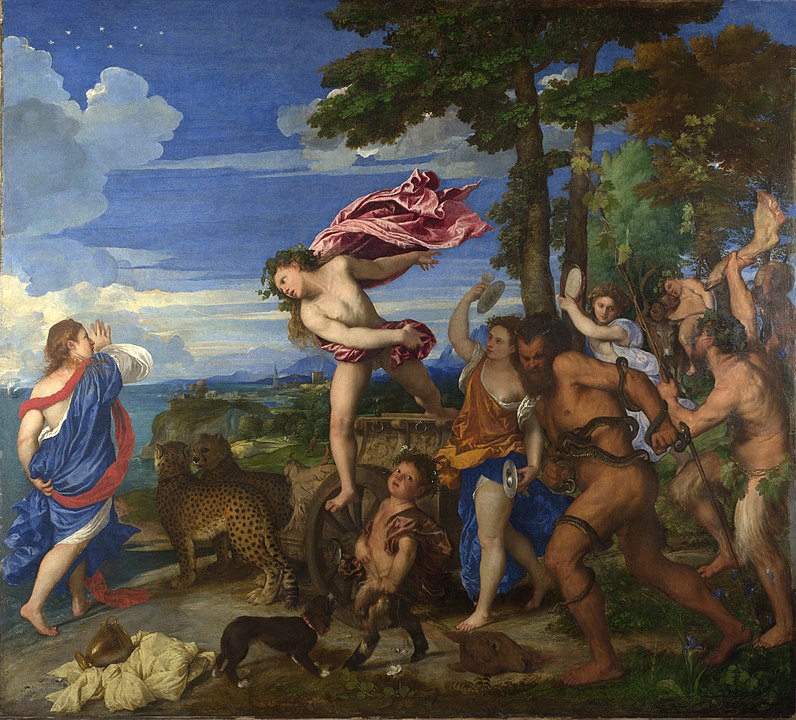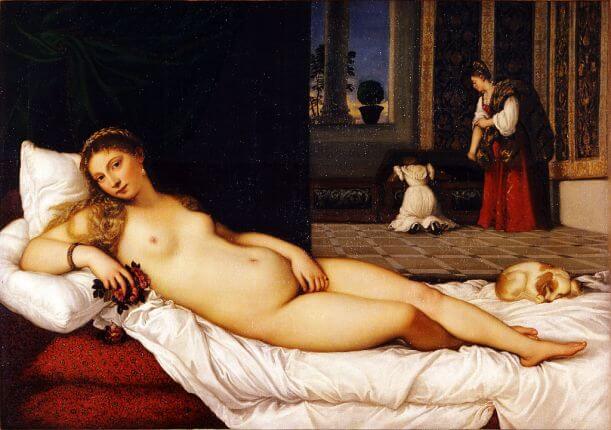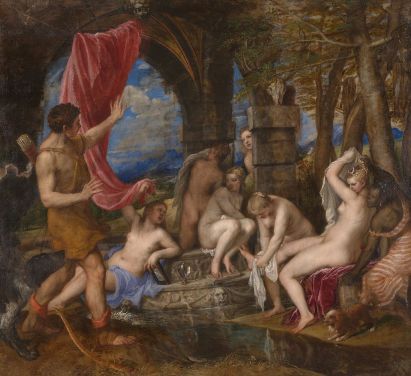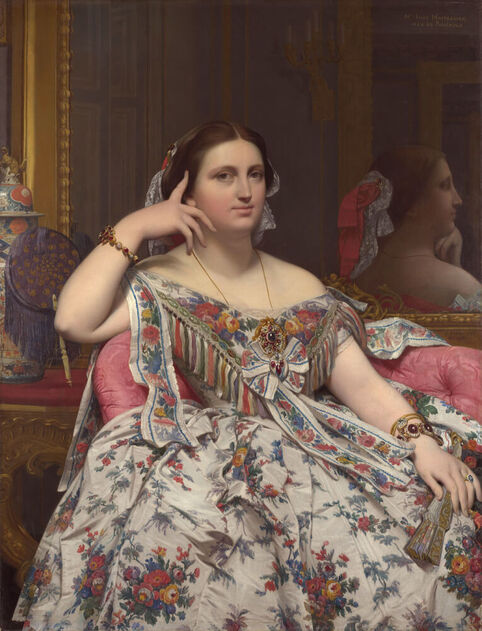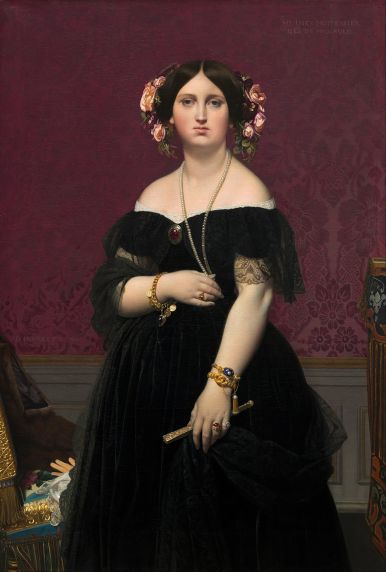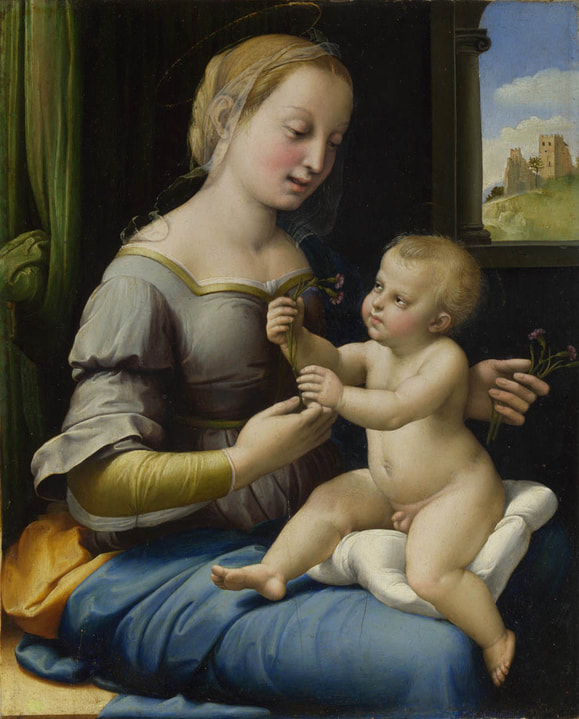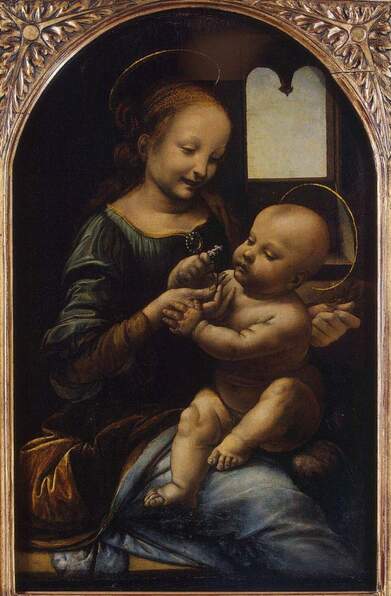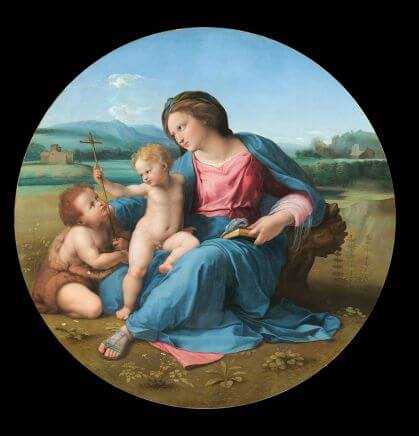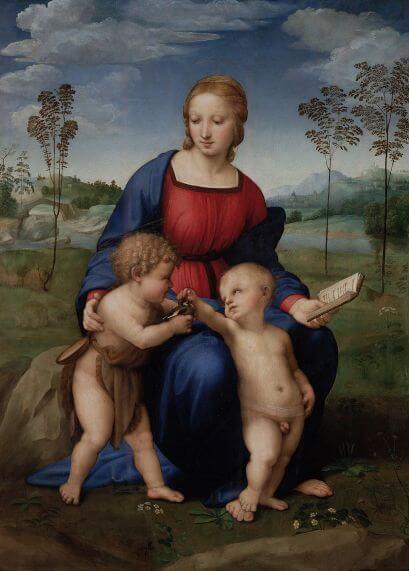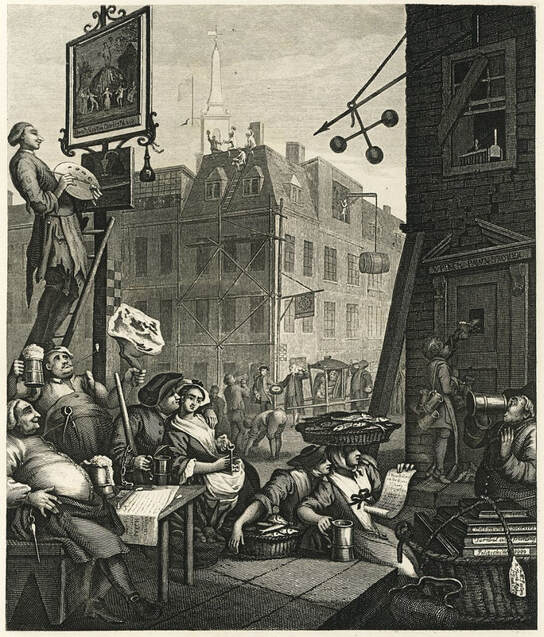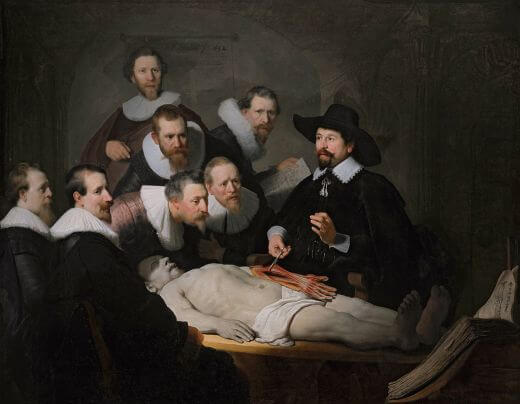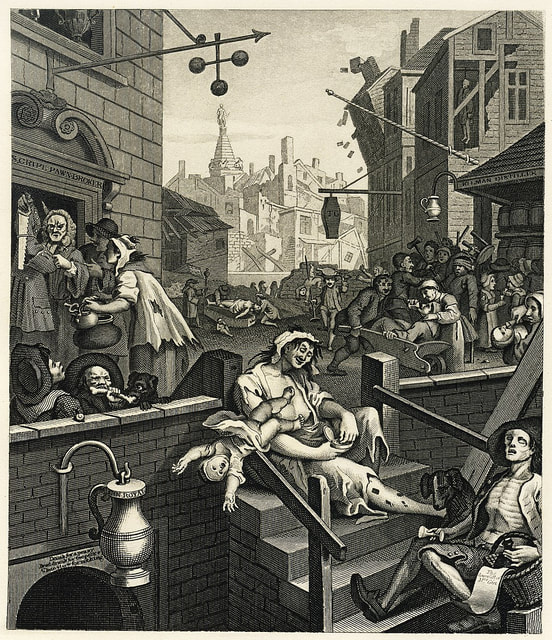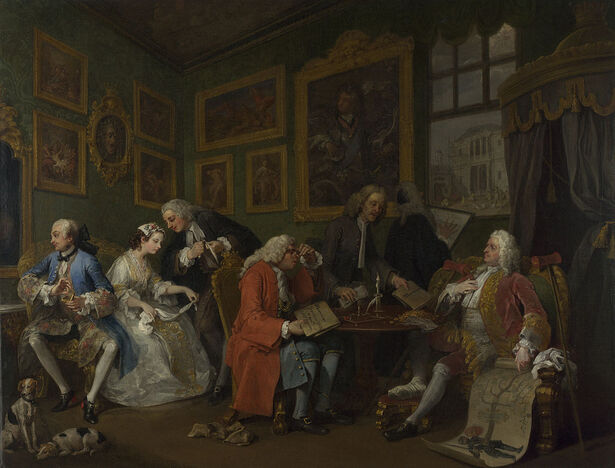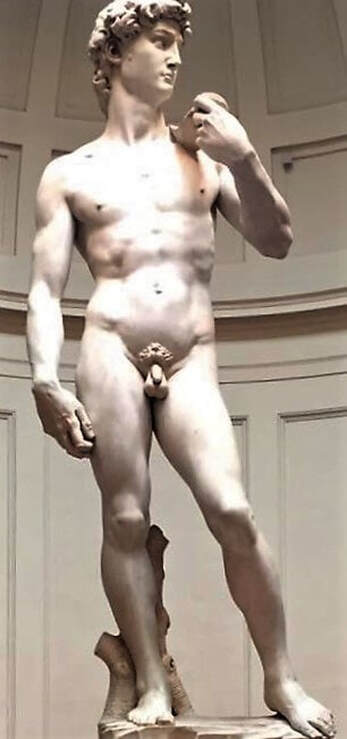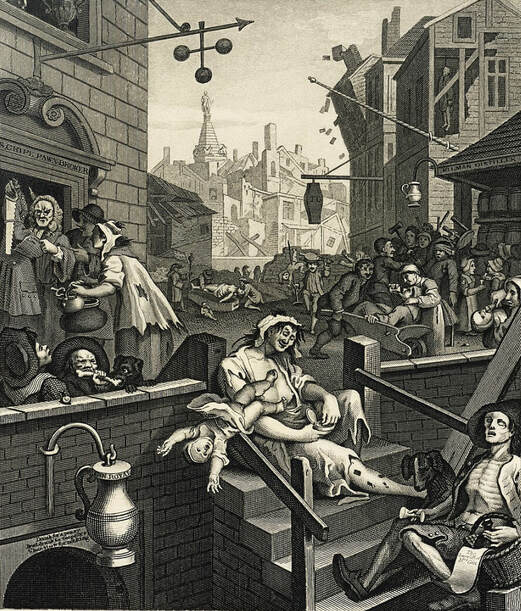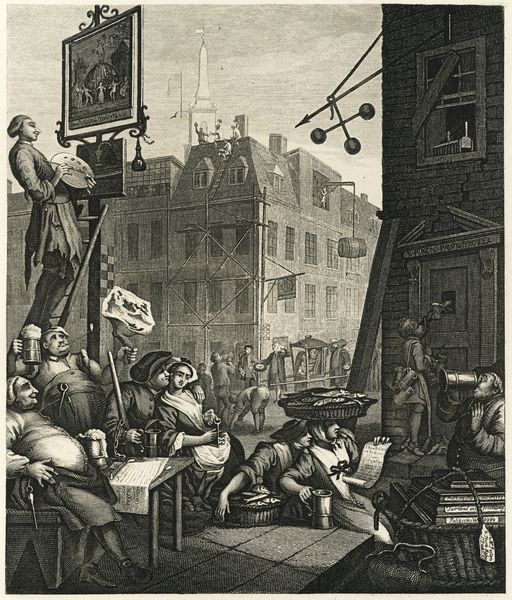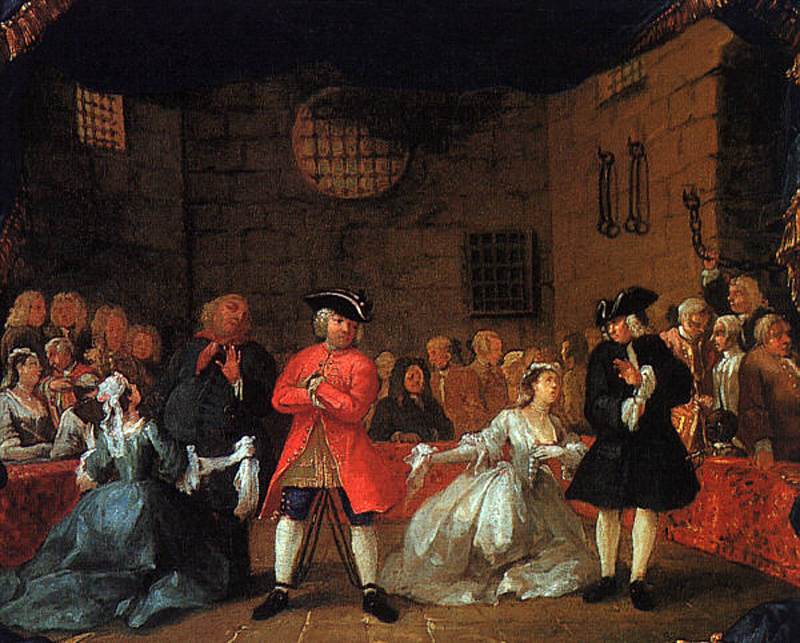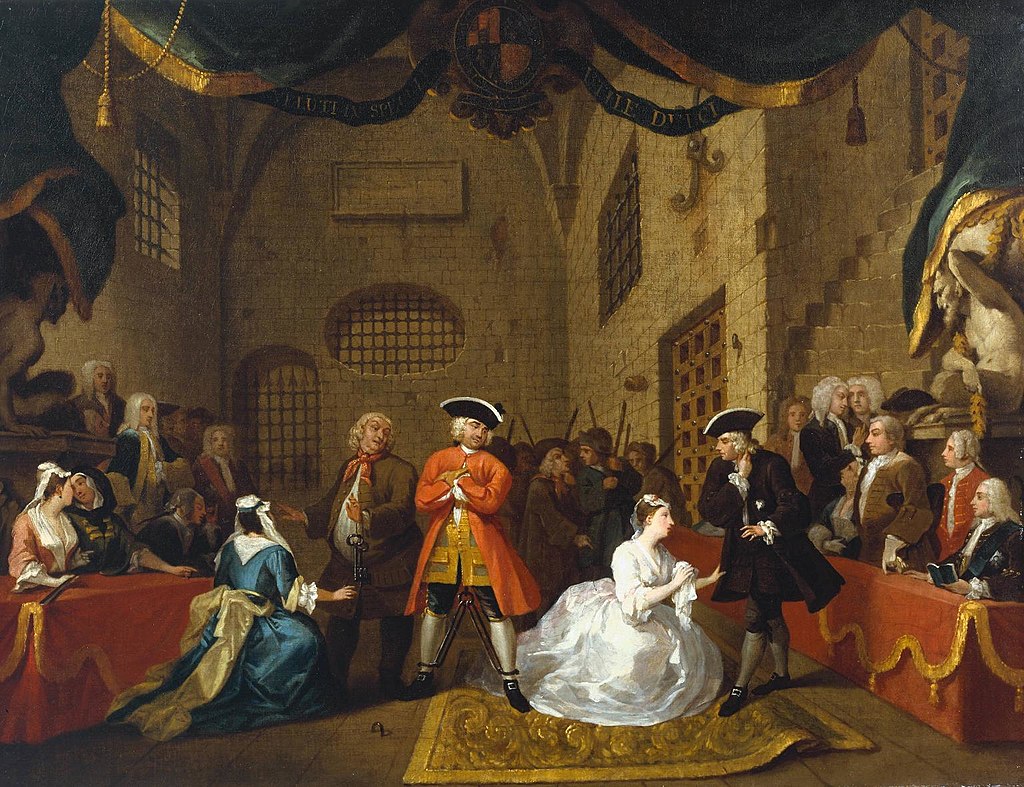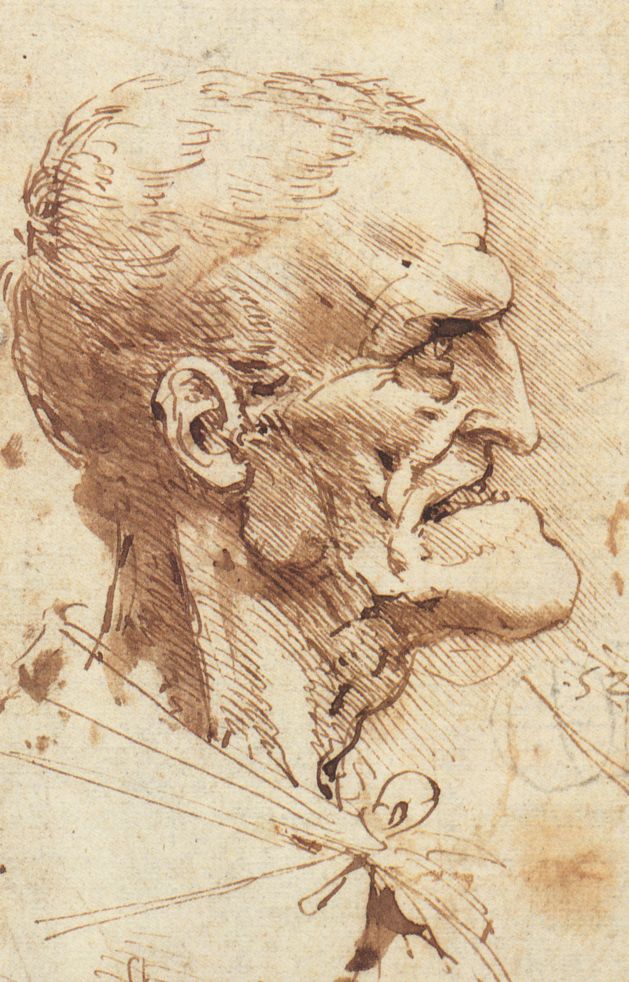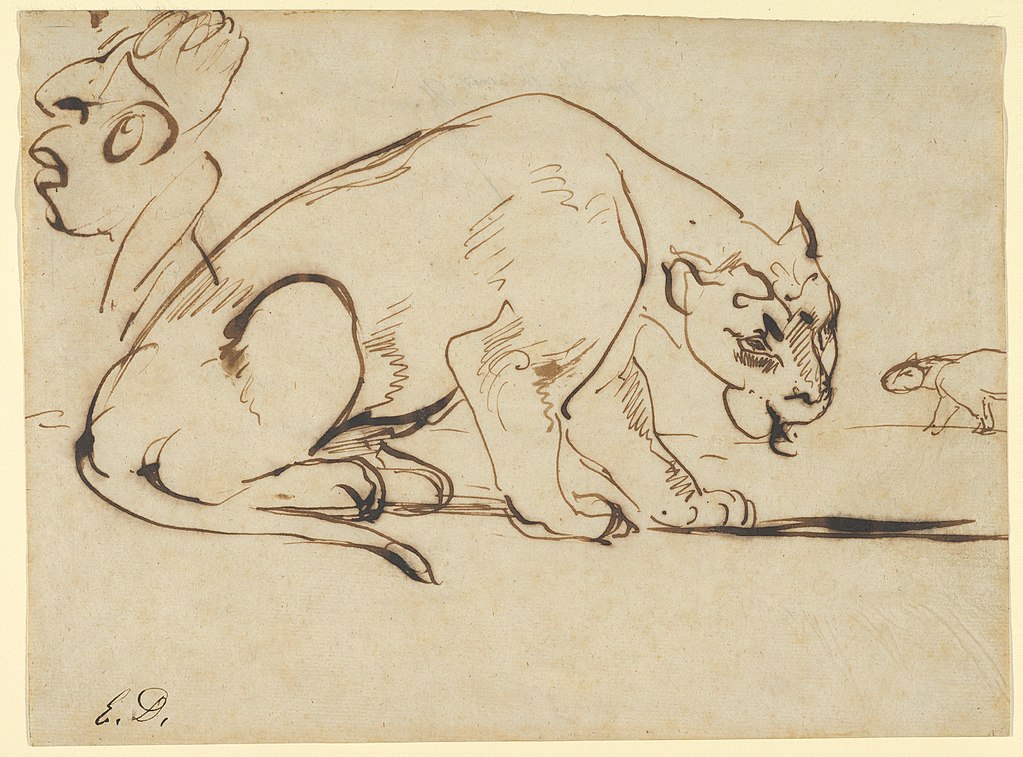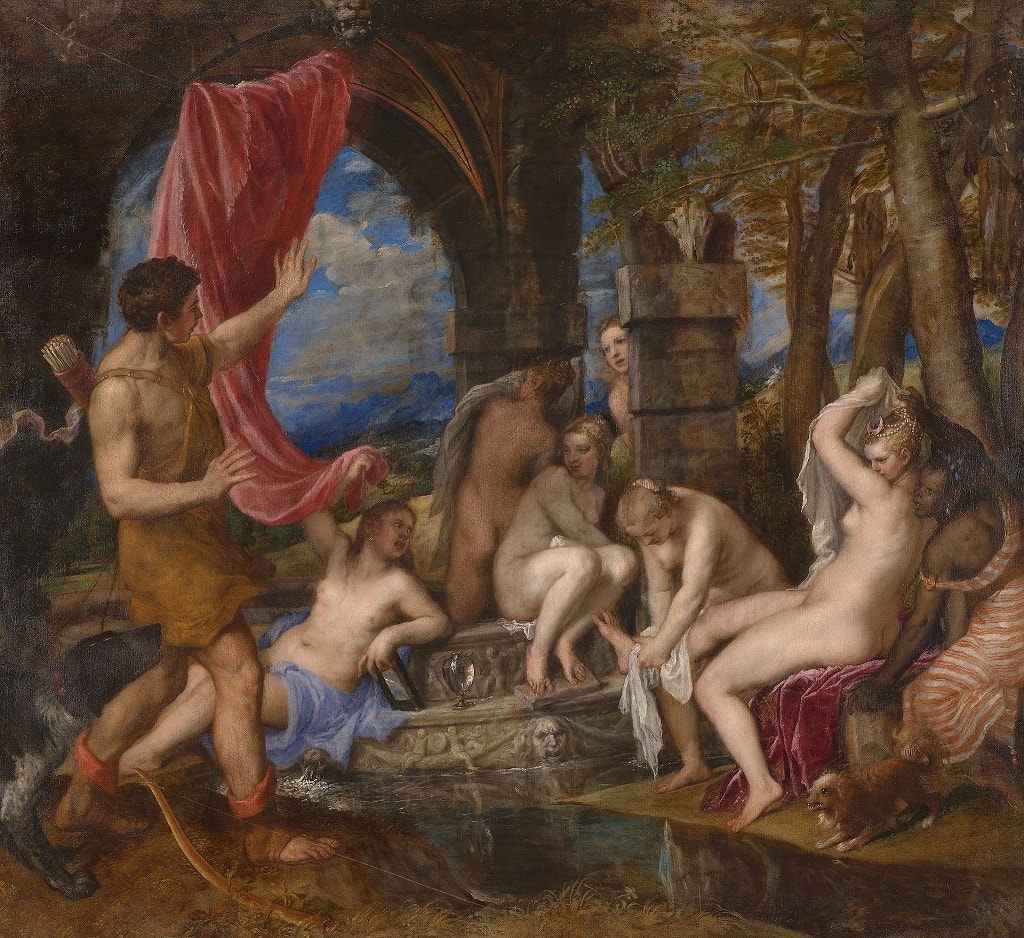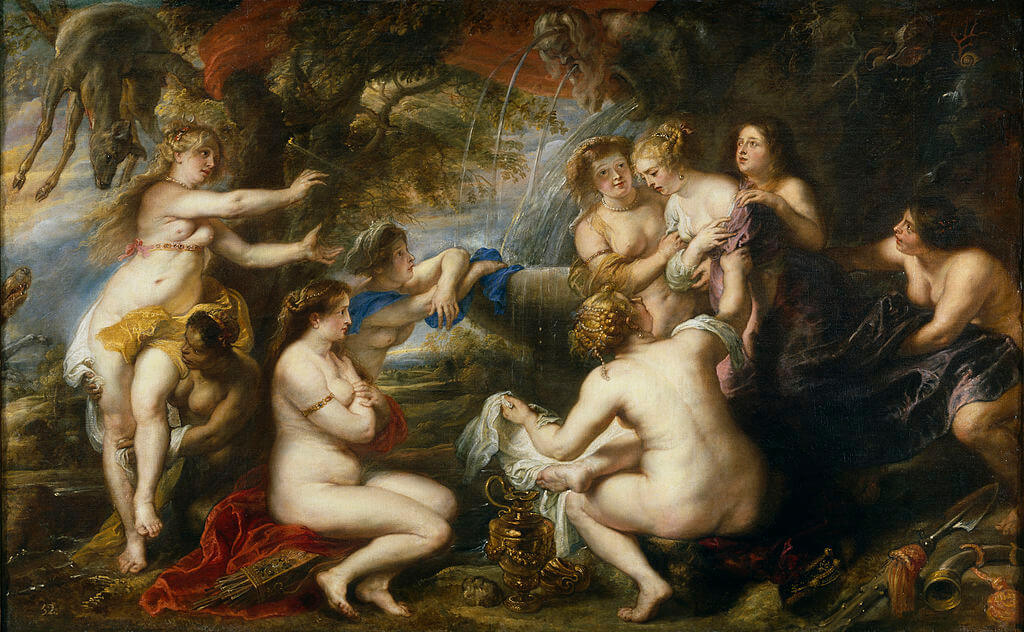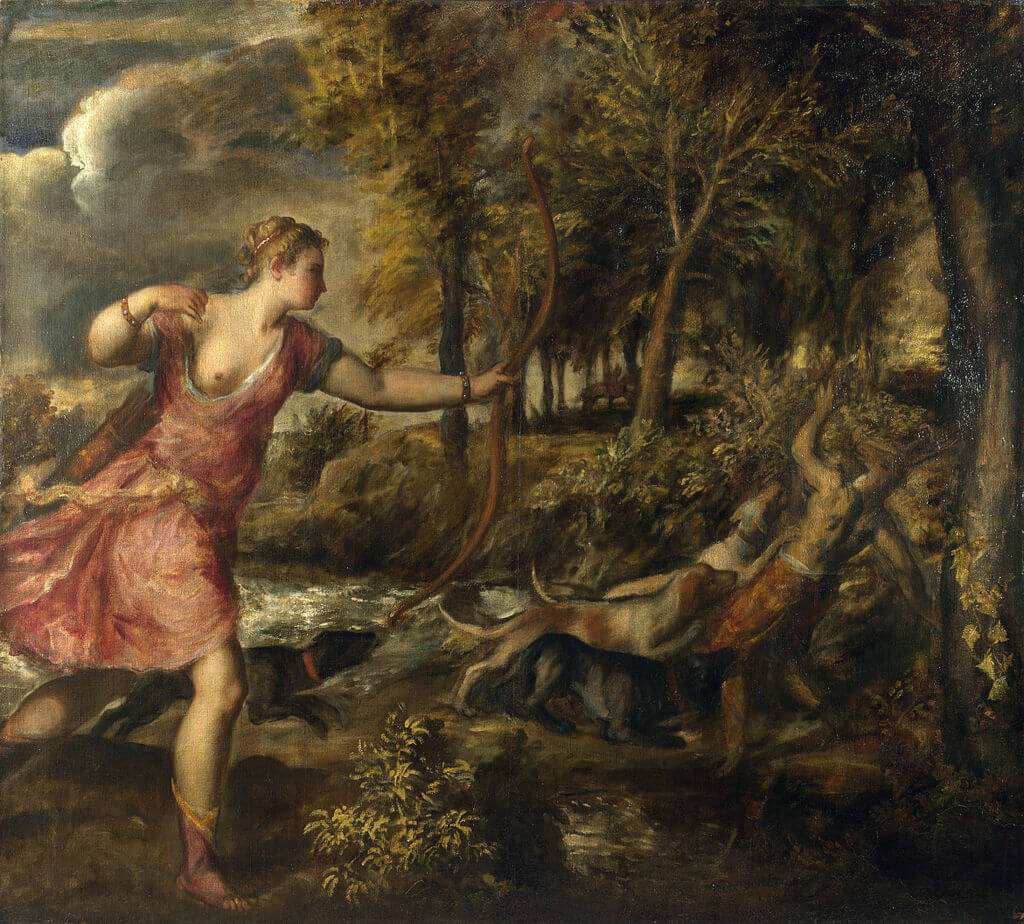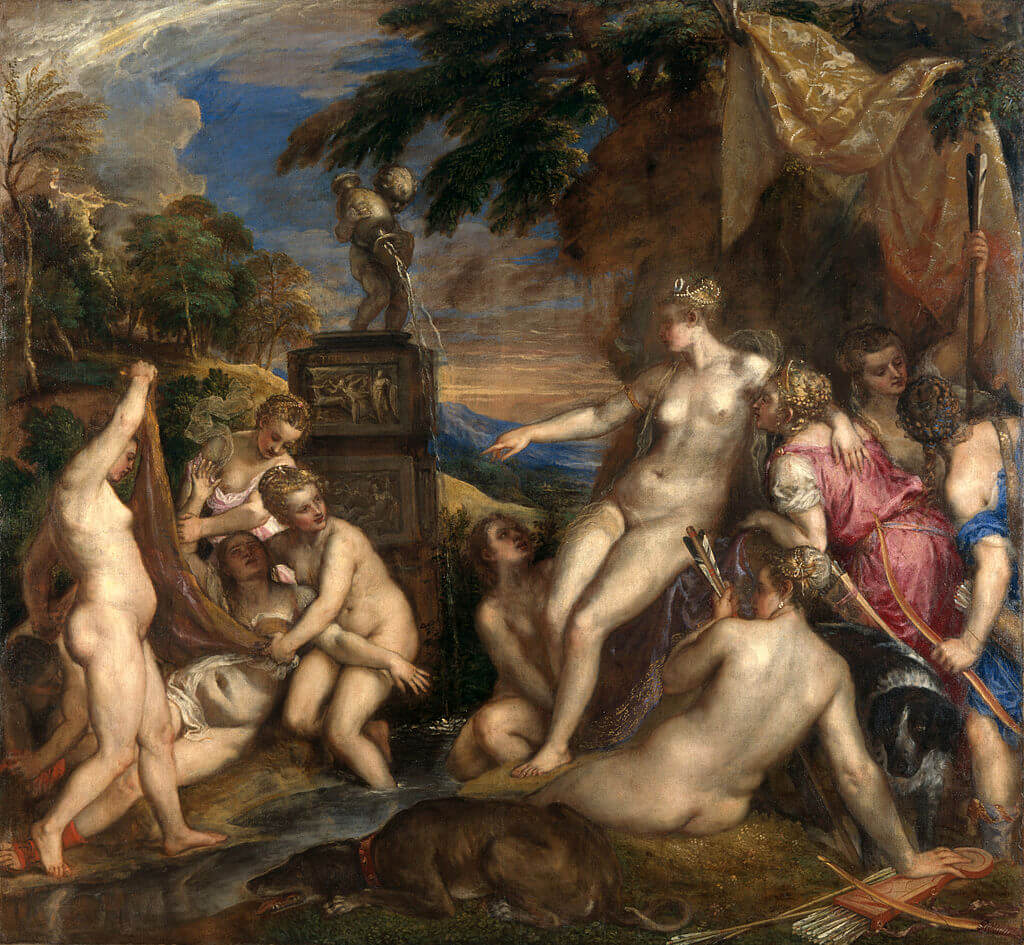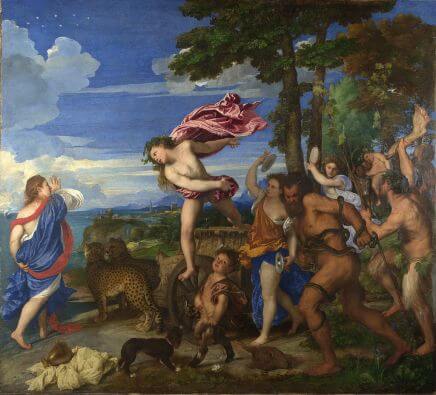|
Where? Room 56 of the National Gallery
When? 1434 Commissioned by? Possibly Giovanni di Nicolao Arnolfini, an Italian merchant living in Bruges, as a memory of his deceased wife. What do you see? On the right is a woman in a green dress. On the left is a man with a big hat who raises his hand to the woman. The couple is holding hands. It is believed that this is their wedding day and they are dressed in expensive silk and fur. A small dog is standing in front of them. At first, it looks like the bride is pregnant, but this is not the case. When you look carefully, she pulls up her dress merely to indicate her desire for children. In between the couple, you can see a small part of an expensive Oriental rug. In the mirror, we can see two other people that entered the room. The mirror is surrounded by ten small paintings of the passion of Christ. Below the mirror is the signature of Van Eyck which reads: ‘Johannes de Eyck fuit hic 1434’, which means ‘Jan van Eyck was here, 1434’. This signature may suggest that Van Eyck is one of the people we can see in the mirror. To the left of the mirror hang, so-called, prayer beads of crystal. Above the couple is a chandelier with candles. Only one of the candles above the groom is lit. The couple has both taken off their shoes. The white with black shoes of the man are in the left foreground and under the red bench is a pair of red shoes from the woman. On top of the bed is a wood carving of Saint Margaret with a dragon at her feet. To the left of this carving hangs a hand brush. On the left of the painting are four oranges and outside you can see a small part of a cherry tree.
Backstory: This painting is known by several alternative names, such as The Arnolfini Double Portrait, The Arnolfini Marriage, and The Arnolfini Wedding.
The painting probably depicts Giovanni di Nicolao Arnolfini and his wife Giovanna Cenami on their wedding day, and the painting serves as a kind of marriage certificate. Giovanni was a rich Italian merchant from an influential family in Lucca in Italy. At the time of this painting, he was living in Bruges, which was an important trading city. He probably remained there for the rest of his life. This painting not only celebrates their marriage but is also a way to show off the valuable possessions of the couple. Around 1438, Van Eyck created another portrait of Giovanni, which is now in the Gemäldegalerie in Berlin.
Symbolism: This painting is full of symbolism. The couple holding hands represents the unity of the couple through marriage. The prayer beads are a gift from the groom and represent purity in the marriage. The couple has both taken off their shoes indicating that this is a sacred place.
Standing with bare feet also represents fertility. The green dress of the woman also represents fertility. The carving of Saint Margaret symbolizes her role as the patron of childbirth. The bulge in the dress of the woman indicates her desire for children. She is standing in front of the bed, which further emphasizes this desire and shows her role in the marriage. The man is standing near an open window symbolizing his role in the outside world. The red color of the bed and the bench represent passion. The dog represents fidelity. The hand brush represents the role of the woman as a housewife. The oranges are also referred to as Adam’s apples and represent the forbidden fruit that Adam and Eve ate in the paradise. They should remind the couple not to fall prey to the sin of lust. Only a single candle above the man on the chandelier is lit. The candle above the bride is not lit anymore (you can still see the leftovers of a burnt candle) and may refer to the fact that she died already. If Giovanni di Nicola Arnolfini is indeed the commissioner of this painting, his wife died in the year before the creation of the painting. The lit candle also represents the eye of God who can see everything. Who is Van Eyck? Jan van Eyck was born between 1380 and 1390 in Belgium and died in 1441. He was well educated and active in Belgium, France, and The Netherlands. He was a court painter, but also took private commissions of which most were portraits. In addition, he served as a diplomat for the government. Jan van Eyck is considered one of the most important painters of the Northern Renaissance. He has created both religious and nonreligious works which was fairly rare during his time. He was one of the first painters to sign his paintings and one of the first to use oil paint instead of the tempera method which was common during his time. Van Eyck had a big influence on many future Flemish and Dutch painters, including Johannes Vermeer. His most famous work is the Ghent Altarpiece in the St. Bavo's Cathedral. He created this piece together with his brother Hubert van Eyck.
Fun fact: It is hard to believe that during the time of this painting, couples could marry without the presence of a priest or any witnesses. In this painting, the couple gets married in a domestic setting, and only the presence of a notary was required. This is surprising given the important role of the church in society during that time.
Only since the Council of Trent, between 1545 and 1563, it was required that a priest and two witnesses needed to be present for the marriage to be valid. The presence of witnesses is still a requirement for weddings in a large part of the world. Interested in a copy for yourself? Poster of canvas (Amazon links).
6 Comments
Where? East Galleries II on the first floor of the Wallace Collection
When? 1664 What do you see? A party to celebrate the arrival of a newborn baby. In the middle, a father holds his newborn. He wears a so-called kraamherenmuts, a typical cap worn by new fathers. On the left, the mother lays in her bed (below the canopy on the top left). Friends and family surround the father and baby. The scene is chaotic but happy. People engage in all sorts of activities, and bowls, pans, plates, egg shells, and food are scattered throughout the room. In the foreground, a maid is shown from the back. She is dressed in happy colors and holds a red chair for the father to sit in. The woman standing on the right side (from our point of view) from the father will receive some money from the father who puts his left hand in a money bag. In the right foreground, a smiling woman is stirring in a large pot and holds up her hand to receive some money as well. Another woman helps her pouring sugar into the pot. The maid on the right is getting a sausage that hangs from the chimney. On the left, two people are paying attention to the mother, and one of them feeds her some soup. To the left of the table, a pregnant woman sits next to a crib. She holds a glass in her left hand and conceals her belly with a white apron. Backstory: This painting has been known under several titles, including The Christening, The Christening Feast, and The Gossiping. Steen signed the painting by writing JSteen.1664 above the door. In addition, the long-haired man behind the father may be a self-portrait of Jan Steen. The painting has been altered a bit over time, but a large cleaning in 1983 removed some of the 19th-century additions. For example, you can still see that the plate in the hand of the woman on the right (getting the sausage) was originally larger. Sir Richard Wallace acquired the painting on May 15, 1872. Jan Steen made several other paintings about the celebration of the birth of a child. For example, in 1668, he painted Twin Birth Celebration, which is in the Kunsthalle in Hamburg.
Symbolism: The marriage between the husband and wife is not good as there are hints that both are cheating on each other (see the fun fact below for more on this). The broken egg shells in the foreground could both symbolize the lack of sexual intercourse within the marriage and sexual intercourse outside the marriage (also notice the bits of egg yolk on the floor). The eggs were also used to produce an alcoholic cinnamon-based drink which was a traditional drink for the mother to recover from the childbirth.
The item on the bottom left, which looks like a frying pan, is a bed warmer. It refers again to the bad state of the marriage as the bed warmer indicates the only warmth there is in bed. Furthermore, the sausage hanging on the top right is also a sexual reference. Steen wanted to remind people with this painting of the importance of a good marriage. Who is Steen? Jan Havickszoon Steen (1626-1679) was a painter from The Netherlands who is best known for the comical and ironic themes in his paintings. His works often include chaotic scenes from everyday life. Typical examples are The Merry Family in the Rijksmuseum in Amsterdam and Rhetoricians at the Window in the Philadelphia Museum of Art. However, he was quite versatile and also created mythological, religious, still-life, and portrait paintings. Jan Steen was the son-in-law of Jan van Goyen, a successful landscape painter from the 17th century. Steen did not always earn enough money with his paintings and ran a brewery and an inn at different points in his life. Observing people having some drinks must have been a great inspiration for Steen as this is a theme that he frequently incorporated in his paintings.
Fun fact: Typical for Jan Steen, this painting contains some comical details, but at the same time these details completely change the meaning of the painting. For example, look right above the head of the baby. A man is raising his two fingers, which was a sign of infidelity. It is a sign that the man raising his fingers is the birth father of the child, while the man holding the baby is only the official father (as his wife has cheated on him). The woman on the right with the large breasts jokingly opens her hand to receive some money from the father. She may be the midwife, but also a little bit more than that…
Interested in a copy for yourself? Poster or canvas.
Where? Room 66 of the National Gallery
When? 1495-1508 Commissioned by? Prior Bartolomeo Scorlione and the Confraternity for the Chapel of the Confraternity of the Immaculate Conception in the church of San Francesco Maggiore in Milan. What do you see? The Virgin Mary, the children Jesus and John the Baptist, and an angel are pictured in a triangular composition in a rocky environment. The Virgin Mary is sitting on the ground, which is referred to as the Madonna of Humility. She is the center of attention in this painting. The right hand of Mary is on the shoulder of John the Baptist (who is the child on the left). The left hand of Mary is right above the head of Jesus, which can be interpreted as a protective gesture. John the Baptist is folding his hands and is praying towards Jesus. At the same time, Jesus, who is directly to the left of the angel, is raising his right hand to bless John the Baptist. The angel most likely represents the Archangel Gabriel, even though the angel looks quite feminine (the painting of androgynous figures was a trademark of Leonardo da Vinci). In the background you can see the rocky grotto and a river, most likely inspired by the Dolomite Mountains, which are to the northeast of Milan. In the foreground and the grotto, various flowers and plants are depicted (including irises, lilies, and ivy). Backstory: The commissioner of this painting wanted Leonardo da Vinci to paint the Immaculate Conception (a Catholic dogma that Mary was born without sin) to serve as the center of an altarpiece for the Chapel of the Immaculate Conception. This chapel is part of the Saint Francesco Grande church in Milan, and the chapel has been founded before 1335 by Beatrice d’Este, who was the wife of Galeazzo I, the Duke of Milan. On the left and right of this painting would be two paintings of angels playing a musical instrument to complete the altarpiece. On the left is An Angel in Green with a Vielle painted by an associate of Leonardo, possibly Francesco Napoletano. On the right is An Angel in Red with a Lute by Giovanni Ambrogio de Predis.
Leonardo da Vinci has painted the biggest part of this work but he has some help from his assistants. One important argument, according to The Guardian, which supports the involvement of some assistants is that some of the flowers and rocks are not accurately depicted (whereas one of the trademarks of Leonardo is that he was always very accurate in depicting natural elements in his work).
Symbolism: The rocks and caves represent sanctuary. The rocks also refer to Jesus, who is often called the rock of the Christian religion. The flowers and plants are also carefully chosen. For example, the palm leaves, which can be seen behind the head of John the Baptist, are a symbol of Mary and a symbol of Jesus victory over earthly temptations. The angel is clearly identified based on his wings. Mary is directly visible by her blue clothing and the halos help us to identify who is sacred/holy. John the Baptist can easily be identified by his cross of martyrdom. Who is Leonardo da Vinci? Leonardo da Vinci (1452-1519) was born in the Italian village of Anchiano, which was very close to Vinci, which is where he got his name from. He was an architect, astronomer, engineer, inventor, mathematician, musician, painter, writer, and much more. Leonardo da Vinci is known to be one of the biggest multi-talented people that the world has ever seen. Leonardo was notorious for being substantially late in delivering his paintings and was not afraid to abandon projects halfway. Most of the surviving paintings of Leonardo have become famous, including The Annunciation (in the Uffizi Museum) and the Mona Lisa (in the Louvre).
Fun fact: Interestingly, there are two versions of this famous painting. The other version of The Virgin of the Rocks is in the Louvre.
The version in the Louvre was the first to be completed and is much less conventional. For example, the current version in the National Gallery contains halos on top of the heads of John the Baptist, Jesus, and Mary, and John the Baptist is carrying a cross with him (these elements are not present in the version in the Louvre). You can also see a clear difference in the face of Jesus. Also, in the National Gallery version of the painting, the angel is not pointing at John the Baptist and seems to gaze in the distance (as if the angel is dreaming/imagining this scene, instead of participating in it). The reason that there are two versions of this painting is that the Confraternity rejected the first version of Leonardo. It was not traditional enough (for example, no halos and a lack of symbolism) and thus did not suit the purpose of representing the dogma of the Immaculate Conception (which was the sole purpose of the Confraternity). Leonardo da Vinci considered the Louvre version of the painting a real masterpiece in which he could perfectly express his artistic ideas. After the Louvre version of the painting was rejected, Leonardo created another version of this painting (the current version), which included all elements that the Confraternity asked for. Interested in a Copy for Yourself? Poster
Where? Room 43 of the National Gallery
When? 1888 What do you see? A total of 15 sunflowers is depicted. The sunflowers are actually dying, and you can see that almost half of the sunflowers does not have any petals left. Specifically, six sunflowers only have their flower head left, and the sunflower on the top right only has a single petal on it. This is an indication that they are at the end of their life. The sunflowers that we often adore are the ones with the petals still on it, and in combination with the flower head, they make the sunflower look like a sun with rays. The petals of the sunflowers that still have them are quite spiky. Notice also the colors that Van Gogh used. Besides some green, he used different shades of yellow. It is very difficult to create a painting with a clear subject and interpretation with such a limited array of colors, yet Van Gogh succeeded in creating a painting of sunflowers that can be recognized from a large distance. This still-life painting beams of the wall and energizes people around the world, something that is very uncommon for still-lifes which are often considered to be somewhat dull. Backstory: A painting of sunflowers is immediately associated with Van Gogh. He created a total of 11 paintings of sunflowers. The first series of four paintings shows sunflowers lying on the ground and the second series of seven paintings shows sunflowers in a vase. This second series contains four originals which he created in a single week. Van Gogh also made three copies of the paintings in the second series. Two of these three copies are copied from the Sunflowers version in the National Gallery. One of these copies is currently in the Van Gogh Museum in Amsterdam, and the other copy is in the Seiji Togo Memorial Sompo Japan Museum of Art in Tokyo (this version was sold for almost $40 million in 1987, making it the most expensive painting ever sold at that time). Sunflowers for Paul Gauguin: Van Gogh’s idea was to create these sunflower paintings as a decoration for the room of Paul Gauguin who would join him in Arles to paint. He knew that Gauguin liked sunflowers as, in the year before, Gauguin had exchanged one of his paintings for two of the earlier sunflower paintings of Van Gogh. Van Gogh was very excited that Gauguin would visit him and was in a fantastic mood when he created his second series of sunflower paintings. When Gauguin arrived, he was indeed impressed by these paintings and even Van Gogh himself was quite happy with the results (which was uncommon for him). The interest of Van Gogh in flowers was probably stimulated by his nationality as flowers are a very big part of the culture in The Netherlands. In fact, The Netherlands is the biggest flower exporting country in the world.
Symbolism: These sunflowers also have a symbolic value (though it is not clear how important this symbolic value was to Van Gogh). Flowers are a symbol of life. They have a period in which they bloom beautifully and they are in their prime, but eventually, they die. The cycle of a flower’s life is often used as an analogy for human life and should remind us of our own mortality. However, inside the flower head are the seeds of new life. These seeds refer to the cycle of life on this planet.
Who is Van Gogh? Vincent van Gogh (1853-1890) was born in Zundert in The Netherlands. He only started his artistic career in 1881 and so all the works we know from him are made within one decade. For many of his later paintings, Van Gogh studied a landscape, the sky, or some flowers in front of him while working on the painting. He liked to be outside while painting. His favorite color, which you can see in many of his paintings, is yellow. He considered yellow to be the color of life (as the sun is also yellow). Van Gogh developed a unique style of painting, which is very recognizable. Especially in his later years, he applied thick layers of paint to the canvas and used heavy brushstrokes. His work appeals worldwide to many people that are otherwise not so interested in art. Fun fact: Van Gogh’s idea was to create a painting community in Arles, where he moved in February 1888, but nobody wanted to join him there initially because of his difficult personality. However, the brother of Vincent convinced Paul Gauguin to join him and Vincent was very excited about this. On October 23, 1888, Gauguin joined Van Gogh in Arles. But the collaboration did not turn out well and Gauguin left in December 1888. According to Gauguin, Van Gogh threatened him with a razor and Gauguin ran away. That same night Van Gogh mutilated his own ear with a razor blade, which caused severe bleeding. He applied a bandage to his ear and packaged his ear in a piece of paper, which he brought to a woman in the brothel nearby that he frequented. He painted a self-portrait with a bandaged ear and pipe which is currently in a private collection.
Written by Eelco Kappe
Where? Room 2 of the National Gallery
When? 1522-1523 Commissioned by? Alfonso d’Este, the Duke of Ferrara, to decorate one of the rooms in his Ducal Palace. What do you see? On the left is Ariadne in a blue dress. She is left behind by Theseus on an island. You can still see the ship of Theseus near the horizon in the middle left of the painting. An almost naked Bacchus is jumping out of his chariot, which is carried by two cheetahs. Bacchus is immediately in love with Ariadne, but Ariadne seems hesitant as she is still dealing with the fact that Theseus left. While her arms and body are still in the direction of the ship of Theseus, her head is turned to Bacchus. Bacchus convinces Ariadne to marry him. Bacchus promises Ariadne to turn the diadem that Ariadne was wearing during their wedding into a constellation of stars, which you can see in the top left of the painting. Bacchus has also brought his entourage of drunk and crazy people on the right. One of his followers is holding the leg with a hoof of a cow that he just ripped off. You can see the head of the cow in the foreground, which is dragged along by a young boy. Completely on the right is a man carrying a barrel of wine and in the foreground, a man is trying to break free from snakes. Backstory: Alfonse d’Este originally commissioned Raphael and Fra Bartolommeu to make this painting but both died before they could start their work. He then decided to give the work to Titian. This painting is based on the mythological stories of the Latin poets Catullus and Ovid. The story is about Princess Ariadne from the Greek island of Crete. She fell in love with Theseus from Athens and helped him to kill the Minotaur. They left together from Crete, but Theseus abandoned her while she was asleep on the Greek island of Naxos. Ariadne was heartbroken when she discovered that Theseus had left and ran along the beach of Naxos to see if she could see any signs of him. At that moment, Bacchus - the god the wine, fertility, madness, theatre, and religious ecstasy - arrived. Bacchus had fallen in love with Ariadne and asked her to marry him. The painting is famous because Titian is able to paint a moment that is frozen in time in a very energetic scene. Notice also the beautiful use of bright color, typical for the School of Venice, which makes this painting come alive.
Symbolism: Bacchus is wearing a crown of ivy leafs, which is the sacred plant to Bacchus to prevent intoxication (which is what people in the past believed that ivy could do). The constellation of stars (which we now refer to as Corona Borealis) on the top left is in the form of the diadem that Ariadne was wearing when she married to Bacchus. It is a symbol of their marriage.
The wine barrel, tambourines, and snakes are all symbols of the lifestyle that Bacchus represents. The cheetahs refer to the collection of wild animals of the commissioner of this painting. Who is Ariadne? According to Greek mythology, Ariadne was the daughter of Minos, who was the King of Crete. Minos had built a labyrinth, with in the center a Minotaur (a creature with the head of a bull and the body of a human). He put his daughter Ariadne in charge of the labyrinth. Following an earlier dispute with Athens, every seven to nine years, 14 noble citizens from Athens were sacrificed to the Minotaur. One year, Theseus, was among these 14 noble citizens. Theseus became a hero as he killed the Minotaur, but to do that, he received help from Ariadne who was in love with him. Ariadne married in the end to Bacchus and gave him about 12 children. After Ariadne died, Bacchus brought her back from the underworld Hades and she became a Greek goddess. Why Bacchus? Bacchus was a chronic alcoholic, which made him a great subject for mythological stories and also for artworks. Bacchus was also the inspiration for popular festivals, called Bacchanalia, which were introduced to Rome in the second century before Christ. These festivals contained a lot of alcohol and nudity and were a popular theme in Renaissance art. Who is Titian? Titian (c. 1489 – 1576) was a painter and greatest member of the Venetian school of painters. He was very talented in painting both portraits and landscapes, which is and was a rare combination. In his teenage years, the Bellini brothers (Gentile and Giovanni) taught him how to paint, but his work was quickly considered to be better than that of the Bellini brothers. Some well-known paintings by Titian are his Venus of Urbino in the Uffizi Museum and Diana and Actaeon which is also in the National Gallery in London.
Fun fact: In the original story on Ariadne and Bacchus, the chariot of Bacchus was drawn by tigers. Instead, Titian painted two cheetahs. This was most likely the case, because Duke Alfonso d’Este did not have tigers, but did have cheetahs, in his menagerie.
Collecting wild and exotic animals, called a menagerie, was an impressive way to show off to your guests. Menageries of that time included animals like panthers, leopards, and elephants. Interested in a copy for yourself? Poster or canvas
Where? Room 45 of the National Gallery
When? 1856 Commissioned by? Paul Sigisbert Moitessier, the husband of Madame Moitessier. What do you see? Madame Moitessier is seated on a decorated sofa, also referred to as a canapé. She is wearing a large colorful silk dress with flower patterns. She probably wears a farthingale under her dress, which allows the bottom part of the dress to keep its circular shape. She is looking a bit sensual. For example, look at the blush on her cheeks. Her right hand is casually placed against the side of her head as was often done with Greek statues and she is holding a folding fan in her left hand. You can see the opulence in this painting. Madame Moitessier is wearing expensive bracelets, a ring, a necklace, decorated with various rubies. On the left, you can see a richly decorated screen fan and an expensive vase. Ingres believed that to paint a portrait you have to study the person from all angles and understand all her sides. This is reflected in the mirror that he included in the painting, which shows another side of Madame Moitessier (although it seems unlikely that this mirror is in the correct angle). This side shows her more naturally, with less jewelry. You can also see a candle tree in the mirror. Backstory: Ingres started with this painting around 1847, but only completed it in 1856 when he was 76 years old. He first got the invitation to paint a portrait of Madame Moitessier in 1844, but he refused that assignment as he was focused on mythological paintings. However, when he later met her, he changed his mind as he was very impressed by her looks which made him remember of Juno (the so-called Junoesque look, which means that she looked beautiful and dignified at the same time, just like the goddess Juno). Who is Madame Moitessier? Marie-Clotilde-Ines Moitessier (1821–1897) was the wife of Paul Sigisbert Moitessier, a wealthy banker and merchant. She was also known by her maiden name De Foucauld, which you can see by the inscription at the top right of this painting. Madame Moitessier was also the aunt of Charles de Foucauld, a famous French priest who was beatified by the Pope in 2005. Another portrait of Madame Moitessier: In 1851, Ingres painted another portrait of Madame Moitessier that is currently on display in the National Gallery of Art in Washington, D.C. He painted this second portrait while he had not finished the first one yet.
Who is Ingres? Jean-Auguste-Dominique Ingres (1780-1867) was born in Montauban, in the southwest of France. He was one of the primary Neoclassical painters. He considered himself to be a history painter but also painted quite some portraits during his career. Especially early in his career, he painted portraits to sustain himself. Interestingly, nowadays he is famous for the portraits that he painted.
His perfectionism may cause part of this fame. He found it very difficult to complete portraits, and he often got very frustrated and overwhelmed by these portrait assignments. A large part of his frustration came from the fact that the richer women that wanted a portrait could not hold their pose for an extended period of time. They tended to stand up and look at the painting and change the position of their dress and jewelry while he was painting them. In the end, however, he delivered stunning portraits. Fun fact: Ingres started some initial drawings for this painting in 1844. The idea was the Madame Moitessier was sitting with her daughter Catherine at her knee. Ingres, however, became severely frustrated during this process, partly because he found the daughter of Madame Moitessier very difficult to handle. After a few years, he decided that he should eliminate the daughter from this project, though that did not speed up the process. In 1849, the wife of Ingres died and he decided to stop his work on this painting. Only in 1852, after he remarried, he continued his work on this painting to ultimately finish it in 1856. Interested in a copy for yourself? Poster
Where? Room 60 of the National Gallery
When? 1506-1508 Commissioned by? Probably the Oddi family, a prominent family from Perugia. What do you see? The young Virgin Mary is sitting on a yellow-brown bench with Baby Jesus on her lap and you can see the faint halos above their heads. Mary looks at Jesus and is playing with him. She holds two flowers in her left hand and in her right hand she holds another flower which Baby Jesus is examining. The flowers are identified as pink carnations (also referred to as pinks). Jesus is sitting on top of a white cushion and is absorbed by the flower. Mary is wearing a greyish dress with a belt, and her dress is yellow-gold and white on the top and on her right arm. She also has a blue robe around her legs, and this robe also covers her left side including her shoulder (this is a bit more difficult to see as this blue has darkened a bit over time). She is also wearing a transparent veil in her hair that falls over her shoulders. On the top right, you can look through the window and observe the hills, a castle, and the blue skies. On the left, you can see a green bedcurtain. Note also the quality of Raphael’s work. He carefully combined light and shadow to paint the folds in Mary’s dress and the bodies of Mary and Jesus. His delicate depiction of the translucent veil is also of very high quality. Backstory: This painting is also referred to as La Madonna dei Garofani (which is Italian for ‘The Madonna of the Carnation’) or the Northumberland Madonna (after its previous owner). It is heavily inspired by the Benois Madonna painting by Leonardo da Vinci which can be admired in the Hermitage Museum in Saint Petersburg. The Madonna of the Pinks is a small painting (27.9 cm × 22.4 cm or 11.0 in × 8.8 in), and it may have been created for the nun Maddalena degli Oddi to bring with her wherever she went as an aid for prayer. There are many copies of this painting which are clearly not made by Raphael. However, in 1992, the Duke of Northumberland agreed that the version he owned would be displayed in the National Gallery and could be cleaned and investigated using infra-red reflectography. The investigation concluded that this painting was the original made by Raphael (though some experts still doubt this attribution nowadays). The painting is still in excellent condition, but some cracks can be seen. For example, in the bottom middle, there is a clear vertical crack that runs up through the right leg of Jesus and the back of Mary’s right hand.
Symbolism: The main symbol in this painting is the pink carnation (or pink). According to a legend, this flower first appeared on earth from the tears of Mary that fell on the cross at the crucifixion of Jesus. Pink carnations symbolize the divine love of Mary towards Baby Jesus. They are also seen as a symbol of divine protection and marriage. The pink carnation is still a popular flower for Mother’s Day in the U.S.
The scene of Mary and Jesus is situated in a bedchamber, which is a symbol of maternity. Furthermore, the castle towers seem ruined, which is a symbol of the demise of the pagan world after the birth of Jesus. Who is Raphael? Raffaello Sanzio da Urbino (1483-1520) was born in Urbino in Italy. Together with Leonardo da Vinci and Michelangelo, he is considered to be one of the three prime painters of his time. He moved to Florence in 1504 where he created this painting. During that time he primarily created Madonnas and portraits. In 1508 Raphael moved to Rome to work for the Pope. Raphael often included the Madonna theme in his paintings. For example, the Alba Madonna in the National Gallery of Art in Washington, DC shows Mary, Jesus, and Saint John. Another example is the Madonna of the Goldfinch in the Uffizi Museum in Florence, which also shows Mary, Jesus, and Saint John.
Fun fact: The painting was acquired by the National Gallery in 2004 for almost ₤35 million (which was equivalent to about $60 million at that time). Given its small size, this painting became the most expensive painting ever sold per square centimeter. The acquisition of this painting was not easy, however, as the National Gallery and the J. Paul Getty Museum in Los Angeles were fighting a public battle over this painting.
Both museums were willing to offer an equal amount of money for the painting. However, the National Gallery came up with some very favorable tax advantages for the seller, who was the Duke of Northumberland and thus lived in England. Interestingly, when the painting was discovered in the collection of the Duke in 1991, it was considered a copy of Raphael’s original painting that was missing and only valued at ₤6000.
Where? Room 1730 of the Main Floor of Tate Britain. Several other museums like the British Museum, Metropolitan Museum of Art, and National Gallery of Art also own this work but do not have it on permanent display.
When? 1751 What do you see? Several groups of well-fed people engage in a variety of activities while drinking mugs of beer. It is the birthday of King George II, and that asks for a celebration. On the left, two corpulent men hold big mugs of beer and one of them holds a huge leg of beef in his left hand. In front of them sits a man holding a beer while sharing a romantic moment with a woman. To the right of them, a couple of women with overflowing baskets of fish pause while enjoying a beer. To their right, a young boy with mugs hanging on a rope slung over his back goes around selling mugs of beer. He stops at the pawnbroker to hand him a beer through the peek hole. The pawn shop is in some state of disrepair as people do not need to pawn off their belonging in this prosperous world where people drink beer. The other buildings are well-maintained, and the church steeple on the top is a sign that people behave morally in this world full of beer. On the bottom right, a portly man enjoys his beer next to a pile of books in a basket. On the left, a painter in ragged clothes blissfully paints a cheery picture of men and women dancing around a mountain of barley. On top of the roofs, construction workers take a break drinking to celebrate while another barrel of beer is being lifted up. Finally, in the center, a wealthy woman in a sedan chair waits as her chairmen have temporarily put her chair down to drink a beer. Laborers around them drink their beer while continuing their work in a timely manner. Backstory: Beer Street takes place during a major movement in 18th-century England: The Age of Enlightenment. This was a philosophical and intellectual movement where people began to ponder major scientific and philosophical thoughts that were captured in paintings such as The Anatomy Lesson of Dr. Nicolaes Tulp by Rembrandt. These ideas were published, and many people learned from them and developed them further. Another idea behind the Age of Enlightenment is that people were trying to apply these new ideas to help other people. Before the Gin Craze, French brandy was popular and fashionable, however, during the Second Hundred Years’ War between France and England, French products were considered unpatriotic and soon lost their following. This led to the Gin Craze where gin and other cheap spirits quickly became popular, and overconsumption of these drinks caused many problems among the lower-class people. William Hogarth’s print was, in essence, a piece of propaganda in favor of the British beer market. Similar to the popularity of Coca-Cola in the United States during modern times, Hogarth makes the argument that beer was not only a remedy to the unregulated gin trade but also a drink that is truly British and helps the country.
Gin Lane: At the time Hogarth created Beer Street, he also created a companion piece called Gin Lane. Most museums that own Beer Street, also have a print from Gin Lane as they were created together. Museums owning Gin Lane include Tate Britain, the British Museum and the National Gallery of Art. However, most museums do not have the prints on permanent display as they are light sensitive. The original copperplates for both works are owned by the Metropolitan Museum of Art.
Gin Lane shows the perilous effects that excessive gin consumption can have on your life. It shows the opposite side of Beer Street where drinking gin leads to chaos, negligence, street brawls, and poverty. The only ones benefiting from the gin craze are the distillery, the pawn shop, and the undertaker.
Who is Hogarth? William Hogarth was born in 1697 in London where he would die 66 years later. Hogarth carefully examined life in 18th-century London and detailed it in etchings and painted satires. He included many symbolic features in his works such that his pieces are not only entertaining but also contain several moral messages.
Hogarth created art both for the upper and lower class. He painted works for his richer clients but also created etchings and engravings of his works that could be mass-produced and sold at a lower price to a larger audience. Among his works is a series of satirical works about the British upper class. The first painting of that series is Marriage A-la-Mode: 1, The Marriage Settlement in the National Gallery in London.
Where? Room 1730 of the Main Floor of Tate Britain. Several other museums like the British Museum, Metropolitan Museum of Art, and National Gallery of Art also own this work but do not have it on permanent display.
When? 1751 What do you see? People in various states of physical and mental decline amid a chaotic urban setting. In the center sits a woman with ragged clothes. Her shirt is open exposing her breasts, and she has sores on her legs. She neglects her baby who falls out of her arms and does not even notice what is happening. Just down the steps from her lies a malnourished soldier who looks like a skeleton. He has his head tilted back and holds on to an empty glass of gin. A dog with a saddened expression looks over him. The soldier has a basket tucked under the crook of his arm with a bottle and note that reads “The Downfall of Gin.” To the left of the central woman, two men fight with a dog over a bone signifying how far they have fallen because of their gin addiction. Standing above them, a couple of men try to pawn off possessions to buy more gin. On the right side, more people lose themselves to the cheap spirits. People are feeding gin to each other, including children, and even a baby. In front of the distillery on the right middle, a fight breaks out and people hit each other with chairs and hammers. There is a strong contrast between the different buildings in this town. Most buildings in the background are in poor condition, except the distillery, the pawn shop, and the undertaker’s building. Backstory: Gin Lane is an etching and engraving printed on paper. Hogarth chose this technique to be able to produce multiple prints of his work that he could sell for low prices to lower-class people. Gin Lane showcases the vicious cycle of excessive drinking, pawning off your possessions to drink more, prostitution, and finally death. Gin drinking was considered a large problem in England during the time that Hogarth created this work. It was cheap and accessible to the working class, and many people got addicted to gin with all the bad consequences that result from that. Gin Craze: In the beginning of the 18th century, gin was not regulated in England, and distillers did not care much about the drink’s quality. They mixed in harmful chemicals and did anything to increase their margins. The drink became very popular among the lower class in England, and especially in London. Many people consumed large quantities of gin, which made them even poorer and led to health problems. The problems with gin led the government to take several measures between 1729 and 1751 to make gin more expensive and reduce its popularity. These measures only had a partial effect, and it was not until the 1750s that the gin consumption decreased mainly due to a series of poor grain harvests. Beer Street: At the time Hogarth created Gin Lane, he also created a companion piece called Beer Street. Prints of this work are part of multiple collections, including the British Museum and the National Gallery of Art. The original copperplates for both works are owned by the Metropolitan Museum of Art. Beer Street presents an alternative to the ails of gin drinking. It shows the opposite of the street where we see that beer drinking leads to prosperity. It shows a town that is flourishing with healthy individuals engaging in fun activities. For example, the pawnbroker that thrived in the chaos in Gin Lane is in disrepair as no one wants to pawn items to support their habit.
Who is Hogarth? William Hogarth was born in 1697 in London where he would die 66 years later. He enjoyed creating art which explains the social ills of 18th-century England through a combination of wit and symbols that would be easy to understand for his 18th-century audience. He created art both for the upper and lower class.
Hogarth painted works for his richer clients but also created etchings and engravings of his works that could be mass-produced and sold at a lower price to a larger audience. An example of a work for the upper class is A Scene from 'The Beggar's Opera' in the National Gallery of Art. Another version of this painting is in the same room as Gin Lane in Tate Britain.
Fun Fact: In addition to being a political satirist, William Hogarth is known for his caricatures of people. Look, for example, at the man hanging from the rafters in the top right of Gin Lane or the man in the center walking down the street with a baby on a stake.
Other artists like Leonardo da Vinci and Eugene Delacroix also liked to create caricatures of people. One of Da Vinci’s many caricatures is a drawing of a Grotesque Profile. An example of a caricature by Delacroix is A Lioness and a Caricature of Ingres in the Metropolitan Museum of Art.
Where? Room 6 of the National Gallery
When? 1556-1559 Commissioned by? King Philip II of Spain What do you see? On the left, the hunter Actaeon arrives together with his dog to a bathing scene of the goddess Diana and her five nymphs and one slave. Actaeon is wearing his arrows on his back, and his bow fell on the ground. The nymph on the left draws back the curtain to reveal that Actaeon is looking at the naked Diana at the other side of a small stream. She is sitting on the right, next to a fountain, on the red cloth and is washed by one of her nymphs. Diana wears a diadem with a crescent moon. Diana is surprised by the arrival of Actaeon, and the dark-skinned slave behind her helps to cover her identity by putting a cloth in front of her face. Next to Diana, you can see one of her lapdogs who is barking at the dog of Actaeon. Above the knees of Diana, you can see a skull of a deer on top of a pillar, which is part of an arched canopy. To the right of the skull, you can see a deerskin hanging in the tree and to the right of that hangs another deerskin at the edge of the painting. In the background, above Diana, you can see a very small figure of a person dressed in white who is chasing a deer. This person is probably another depiction of Diana while she is hunting. There are various other details in the paintings. For example, in the middle of the painting, you can see a vase and a mirror. You can also see that the water enters the stream through the mouth of one of the carved lion heads below the nymph on the left. Backstory: This painting is part of a series of seven mythological paintings that Titian painted for King Philip II of Spain. Titian entitled this painting as Diana at the Fountain Surprised by Actaeon. Titian based this painting on the third book of the Metamorphosis by Ovid (Amazon link to the book). The story goes: “While Titania is bathing there... Cadmus’s grandson [Actaeon]… strays with aimless steps through the strange wood, and enters the sacred grove… As soon as he reaches the cave mouth dampened by the fountain, the naked nymphs, seeing a man’s face, beat at their breasts and filling the whole wood with their sudden outcry, crowd round Diana to hide her with their bodies... Diana’s face, seen there, while she herself was naked, was the colour of clouds stained by the opposing shafts of sun... She [Diana] caught up a handful of the water that she did have, and threw it in the man’s face... Without more threats, she gave the horns of a mature stag to the head she had sprinkled, lengthening his neck, making his ear-tips pointed, changing feet for hands, long legs for arms, and covering his body with a dappled hide... They [the dogs of Actaeon] surround him on every side, sinking their jaws into his flesh, tearing their master to pieces in the deceptive shape of the deer.” Symbolism: The skull of the stag (a male deer) with antlers refers to the fate that awaits Actaeon. After having seen Diana naked, she changes him into a male deer and was killed by his 50 hounds. The skull and the deer skins also refer to Diana as the goddess of hunting. The diadem with the crescent moon is one of the important attributes of Diana and also refers to her being the goddess of the moon. The top of the dress of the slave is in the form of a crescent moon, which is also a reference to Diana. Who is Diana? Diana (comparable to Artemis in Greek mythology) is the daughter of Jupiter (Zeus in Greek mythology; god of the sky and thunder) and Latona. She was also the twin sister of the God Jupiter. Diana is the goddess of hunting and wild animals. She could communicate with animals. She was also a virgin goddess who promised never to marry a man. Diana’s story has been a popular subject for artists, and she has been painted by, among others, Rubens and Rembrandt. For example, below is the painting Diana and Callisto by Peter Paul Rubens, which is on display in the Prado Museum.
Who is Actaeon? Actaeon was a famous hunter. He was trained by the centaur (half human, half horse) Chiron. He is best known for his cruel death as described above. The reason that Actaeon is killed is either that he claimed to be a better hunter than Diana or because of his sexual interest in her.
After Actaeon was transformed into a stag by Diana, he was killed by his own dogs who did not recognize him anymore. After the dogs killed him, they went back to Chiron to search their master Actaeon as they could not find him. Chiron, who knew what happened, created an image of Actaeon to help them in their grief. Who is Titian? Tiziano Vecelli (or Vecellio) was born around 1489 and died in 1576. He was the most important member of the Venetian School of Painters. He was an all-round painter and was able to paint superb portraits, landscapes, religious and classical paintings. A large number of paintings of Titian have survived of which several can be seen in the National Gallery in London. For example, two other famous paintings of Titian are The Death of Actaeon and Diana and Callisto, which are both also on display in the National Gallery. Just like Diana and Actaeon, these paintings were also a part of the series of seven mythological paintings that Titian created for King Philip II. Another painting in the National Gallery is Bacchus and Ariadne.
Fun fact: This painting is jointly owned by the National Gallery in London and the National Gallery of Scotland. The painting will rotate every five years between both museums. It was bought by both museums, after an extensive public campaign to raise the money, for a sum of $70.6 million. One of the reasons for the high price of this painting is that the painting was well-preserved over time. One exception may be that the deer skins hanging in the trees are hard to see. The reason is that the copper color that was used here changes into brown after extensive exposure to light.
The painting is currently listed in the top 100 of most expensive paintings ever. Two other paintings of Titian are also listed in this top 100. One of those two paintings is Diana and Callisto, which was bought by the National Gallery in London and the National Gallery of Scotland through a similar construction in 2013 for a total of $71.7 million. |
Categories
All
|
- Home
- Blog
-
Museums
- Alte Pinakothek
- Art Institute of Chicago
- Baltimore Museum of Art
- Barber Institute of Fine Arts
- Bargello
- Barnes Foundation
- British Museum
- Church of Sant’Anastasia
- Cleveland Museum of Art
- Courtauld Institute of Art
- Detroit Institute of Arts
- Frans Hals Museum
- Galleria Borghese
- Gallerie dell'Accademia
- Getty Museum
- Guggenheim
- Hermitage Museum
- Kunsthistorisches Museum
- Kunstmuseum Basel
- Legion of Honor Museum
- Louvre
- Mauritshuis
- Metropolitan Museum of Art
- Musee d’Orsay
- Museum of Fine Arts in Boston
- Museum of Modern Art
- National Gallery in London
- National Gallery of Art
- National Museum in Poznań
- Norton Simon Museum
- Ny Carlsberg Glyptotek
- Palace of Versailles
- Palazzo Pitti
- Palazzo Vecchio
- Petit Palais
- Philadelphia Museum of Art
- Prado
- Pushkin Museum
- Ravenna Art Museum
- Rijksmuseum
- San Diego Museum of Art
- Santa Maria delle Grazie
- St. Peter's Basilica
- Städel Museum
- Statens Museum for Kunst
- Tate Britain
- Tate Modern
- Timken Museum of Art
- Uffizi
- Vatican Museums
- Wallace Collection
-
Artists
- Altdorfer
- Anguissola
- Berlin Painter
- Bosch
- Botticelli
- Boucher
- Bronzino
- Bruegel the Elder
- Brunelleschi
- Cabanel
- Caillebotte
- Canova
- Caravaggio
- Carpeaux
- Cezanne
- Cimabue
- David
- Degas
- Delacroix
- De Maria
- Donatello
- El Greco
- Fontana
- Fra Angelico
- Fragonard
- Gauguin
- Gentileschi
- Gericault
- Gonzalez-Torres
- Goya
- Hals
- Hogarth
- Hokusai
- Ingres
- Leonardo da Vinci
- Lippi, Filippo
- Longhi, Barbara
- Lorrain
- Makovsky
- Manet
- Massys
- Matisse
- Merian
- Michelangelo
- Mochi
- Modigliani
- Monet
- Panini
- Parmigianino
- Perugino
- Picasso
- Pisanello
- Raphael
- Rembrandt
- Renoir
- Reynolds
- Rivera
- Rodin
- Rubens
- Scultori
- Seurat
- Steen
- Tintoretto
- Titian
- Toulouse-Lautrec
- Turner
- Uccello
- Van der Weyden
- Van Dyck
- Van Eyck
- Van Gogh
- Van Hemessen
- Vasari
- Velazquez
- Vermeer
- Veronese
- Vigée Le Brun
-
Locations
- Books
- About Us

